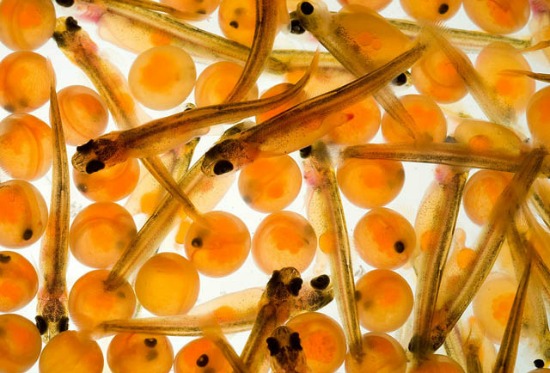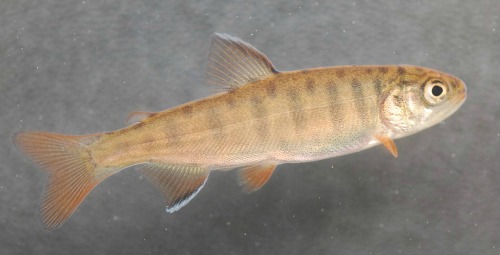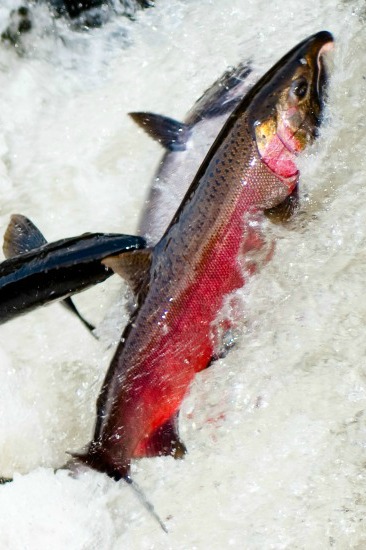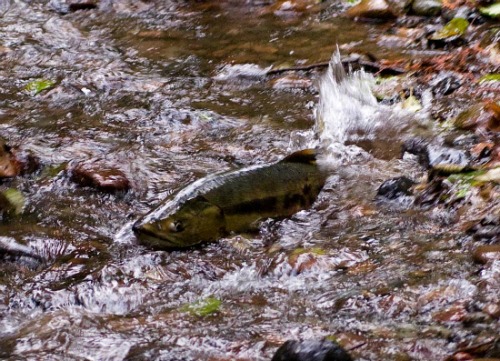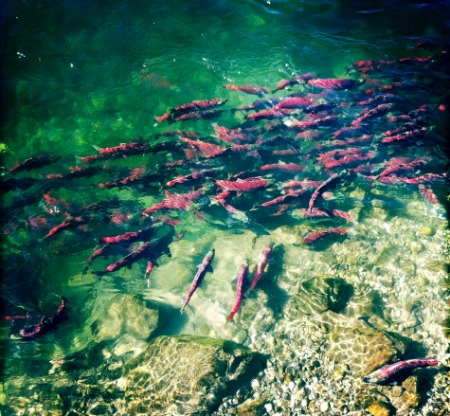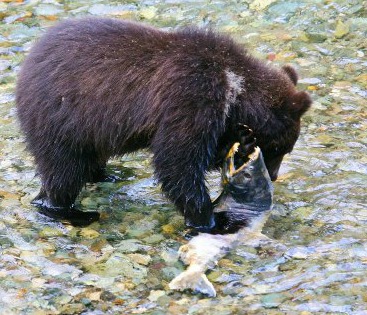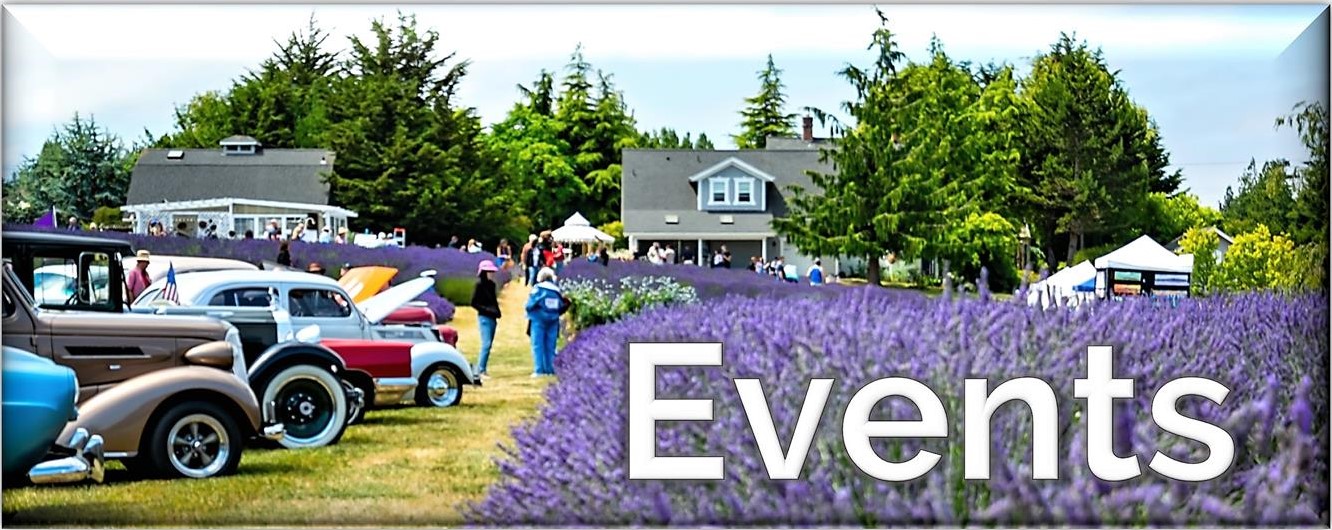Salmon Life Cycle
Salmon Life Cycle. Outline of each stage in the life of a Pacific salmon, from roe to adult salmon to dying salmon kelt. Includes our video of leaping Coho salmon in the Olympic National Park of the Pacific Northwest.
A salmon’s life cycle might span up to 7 or more years.
It starts far inland in shallow gravel-bed streams and ends in the very same stream where it all began.
In the intervening years, a Pacific salmon embarks on a lengthy salt water odyssey throughout Pacific Ocean.
More about the various types of salmon
On this page we’ll focus on Pacific salmon, to enable you to better enjoy your travel and visits to salmon spawning grounds in the beautiful Pacific Northwest.
Pacific Salmon Life Cycle
The salmon life cycle starts with eggs on a gravel stream.
Roe
Roe are salmon eggs. They are deposited in redds, or nests along the gravel bed of spawning streams.
(Below: Salmon roe ready to hatch among recently hatched yolk-sac fry, also called alevins. Image by Flickr user patricksensei - Creative Commons)
The newly fertilized eggs sink to the gravel. The female then swims upstream and sweeps and slaps the bottom of the stream in order to stir up the silt and gravel.
The silt and gravel will drift and settle over the eggs to protect them until they hatch within 2-6 months. In this fashion the female creates her nest, called a redd, which might end up measuring anywhere from 2 – 10 feet long and 1 – 6 feet wide.
A redd might hold up to 1,200 eggs, and a single salmon female might dig 7 redds.
20% of the eggs might survive beyond the alevin stage to become fry.
Alevin, or yolk-sac fry
Alevin are brand-new hatchlings with egg yolk sacs still attached. Alevin remain hidden in the gravel subsisting on the egg yolk on its belly. This stage in a salmon’s life ends when the egg yolk and sac are absorbed, approximately 24 hours.
Fry
Hatchlings that have used up and absorbed the yolk are called fry. Because the yolk sac is exhausted, the tiny fry leave the gravel to find their own food. They subsist on plankton. At this stage of the salmon life cycle they look a lot more like tiny fish.
Some of the newly hatched fry will remain in the freshwater creek for a few weeks (pink and chum salmon), while Sockeye salmon hang out in the creek for 1-3 years before leaving the stream and migrating toward the ocean.
(Below: Image by Flickr user patricksensei - Creative Commons)
Parr
Parr are mottled silvery juvenile salmon still living in freshwater streams. They are highly camouflaged with patterns of bars and spots on their sides.
Smolt
Smolt are juvenile salmon living in brackish river estuaries near saltwater or in the mouths of the rivers. Their bodies must undergo the physiologic changes, called “smoltification,” that will allow them to live in the ocean.
Smoltification may take from weeks to months, depending on the species. Smolt are approximately 15-20 cm (7.5”) long. They lose their mottled camouflage and are silver when they finally head to sea.
(Below: Coho salmon smolt. There are only remnants of the parr striped mottling visible in its skin. This will soon disappear altogether. Image by Flickr user patricksensei - Creative Commons)
Post Smolt
Post Smolt are juvenile salmon during their first year at sea. Post smolt live and swim in schools.
Adult Salmon
Full grown salmon spend from 2 - 6 more years living and navigating throughout the Pacific Ocean in order to feed, build their musculature and arrive at sexual maturity.
(Below: Spawning sockeye salmon. Image by Flickr user soggydan - Creative Commons)
Spawning Salmon
At a certain point of maturity, their bodies tell them it’s time to return back to the very stream where they hatched as alevin.
Once the salmon begin their return trek to freshwater in order to spawn, hormonal changes trigger physical changes in the salmon.
- Depending on species, males develop a hooked mouth (a kype), sharp canine teeth, a bulge or a hump in front of the dorsal fin, and color changes. These changes are important not only for reproduction but also to equip the male to protect its females.
- The changes in the females are much less pronounced, however their color does change.
- Salmon stop eating once they commence the return to sweet water to spawn. The use of their red muscles through jumping and strenuously moving upstream against the current causes a shift of the red muscle pigment into other areas of their body, including the skin.
Spawning salmon are drawn inexorably to their natal spawning grounds. As the multitudes of spawning salmon converge on their respective rivers and creeks, the event is called a salmon run. Salmon runs occur every year, depending upon the species of salmon.
Males and females pair up. The male works hard to protect the female. Some species have grown huge canine teeth with which to ensure his success in spawning.
In the shallow water of a gravelly stream bed, the female ‘cleans’ the stream bed and then lays her eggs (roe) at the same time as the male releases milky sperm, called milt, over the eggs.
How do salmon manage to get back to their birth stream?
A remarkable feature of the salmon life cycle is a salmon's ability to navigate its way thousands of miles through the Pacific Ocean, and then when sexually mature, to home in on the exact stream where it was born up to 7 years previously, in order to spawn. Learn more at Salmon Spawn
The salmon life cycle will start over with the next generation of salmon over the following few months.
(Below: Salmon female is digging her redd by slapping the gravel with her tail. Image by Flickr user soggydan - Creative Commons)
(Above: These salmon are preparing to spawn in their natal stream. Image by Flickr user retrocactus - Creative Commons)
Kelt - End of the Salmon Life Cycle
Salmon that have completed their spawning ritual are known as kelt. Kelts look tattered and trashed. Spawning triggers “programmed senescence,” or rapid aging and deterioration due to the completion of spawning, the lack of eating, and the drain of corticosteroids in their bodies.
For every species of Pacific Salmon, both males and females, spawning marks the last event of their lives. Their immune system and organs fail rapidly, and the exhausted kelts die within a few days to a week of spawning. None survive to spawn another day.
The nourishment supplied by their decaying bodies will return to both land and water and become available to the hatching fry, and to every other species, both flora and fauna, within the riparian environment of the stream.
(Below: Image by Flickr user jitze1942 - Creative Commons)
References:
